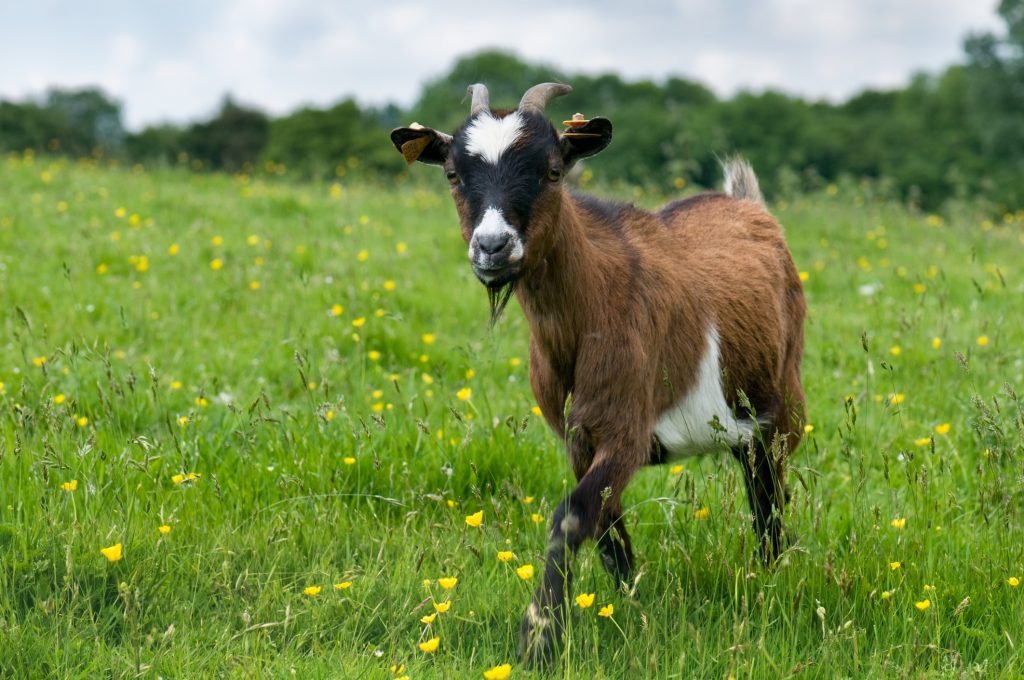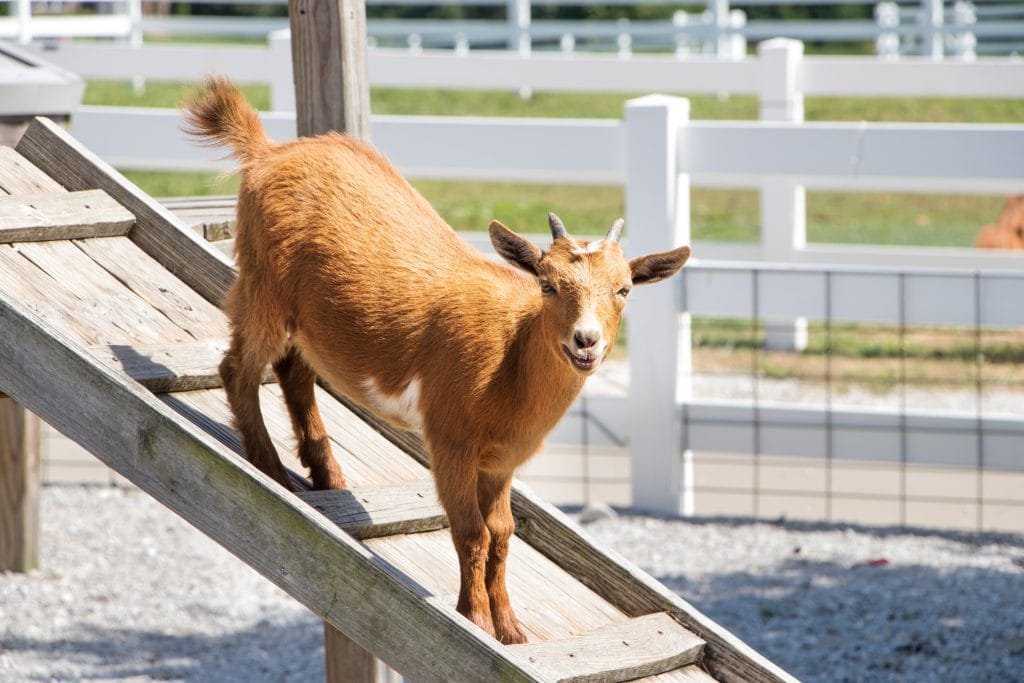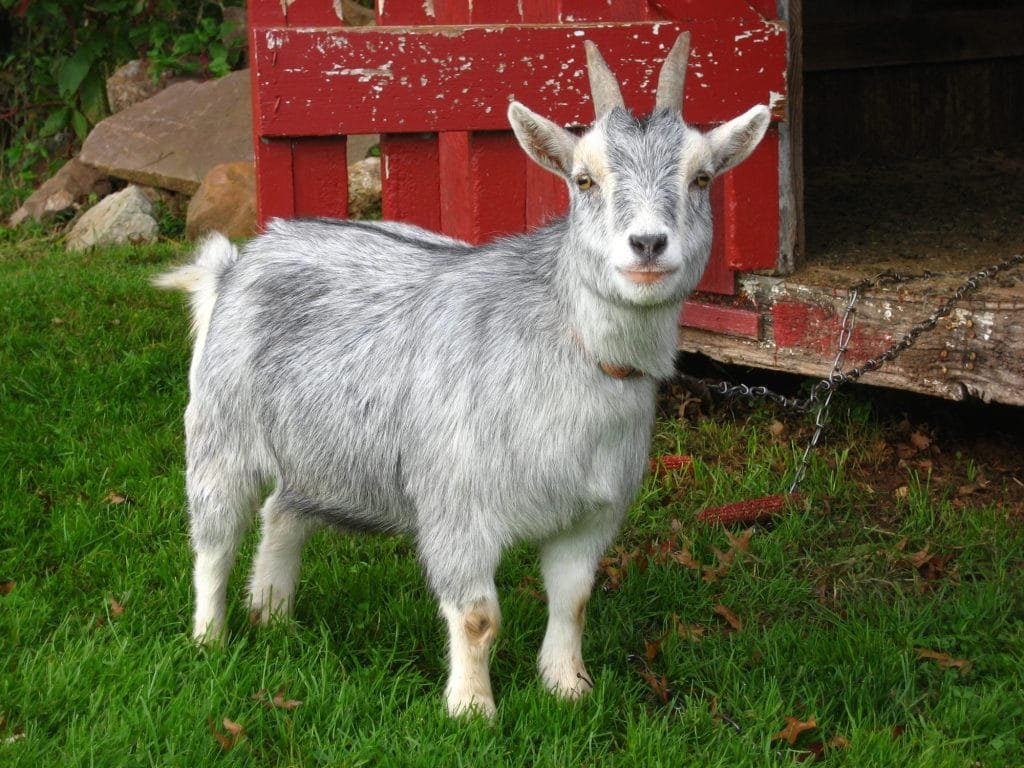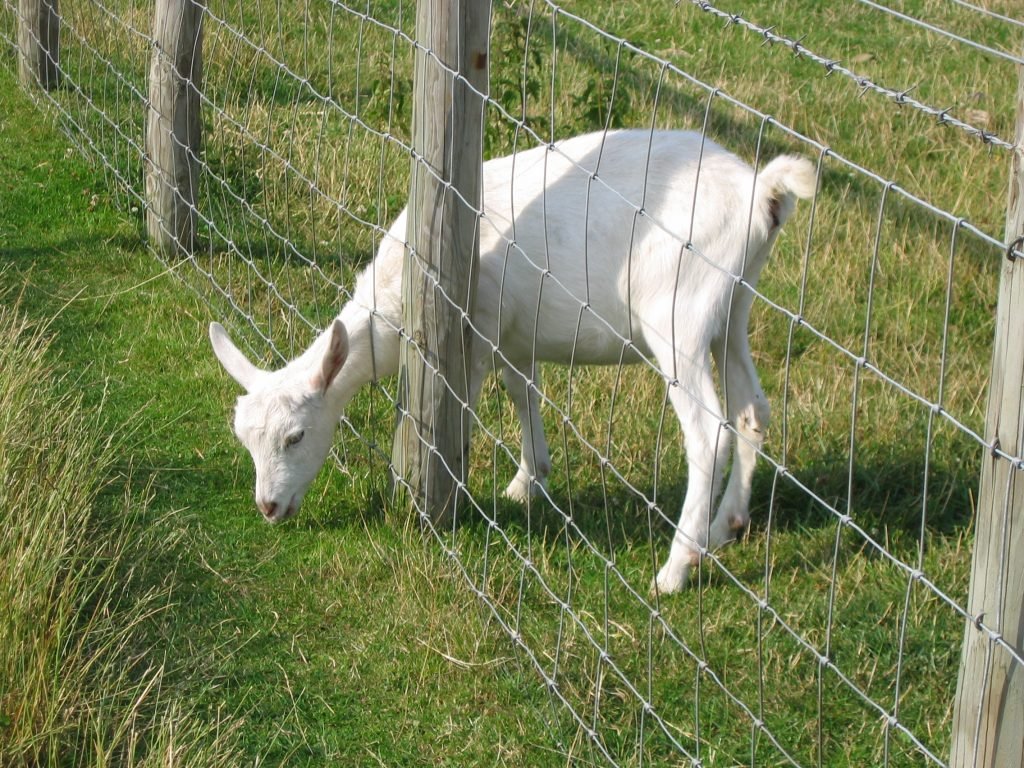This post contains affiliate links.
Goats can be adorable. They are also a low-maintenance cattle option. These social and cute herd animals keep brush from getting out of control and ensure you never see a rose bloom again (joke, sort of). Goats are also a potential provider of milk and meat. But before obtaining a pair or more of long-eared browsers, it is important to assess if you have the space.
An acre of land can house 6-8 goats. Each goat will require 40 square feet for shelter, 30-50 square feet for browsing, and 160 square feet for exercise. If kept in a dry lot they need 200 square feet each. Smaller breeds, such as pygmy and dwarf, need 10 square feet per goat for shelter and 200 square feet for browsing and exercise.
Keep in mind the numbers above are the minimum. Goats are fun animals that can make wonderful pets and be a source of food, such as milk. However, they need space and good fencing, as they are world-class escape artists. Nor are they excellent lawnmowers. Instead, goats prefer to browse, eating shoots and leaves from bushes and other plants, especially at their head level, before they’ll munch on grass.

Why Do Goats Need So Much Space?
Goats require more land than dogs, regardless of whether they are the same size. This fact remains even if you plan to use a “dry lot” where goats do not have pasture to browse. The land is necessary to give them areas to exercise, rest, play, and ensure their waste doesn’t become a hazard.
Goats, contrary to stereotypes, can be incredibly picky eaters. They might eat all the things you wish they wouldn’t, but turn their nose up at their own food if it isn’t presented right. Even when using a manger for their feed, they need plenty of space to keep their waste away from their food. If they step on their food or pee too close to it, they’ll be reluctant to eat.
- Efficient Feeding: Our Tiflev Goat feeders combines feeding and watering into one...
- Large Capacity: With a generous 3.5 quart capacity, this feeder waterer provides ample...
- Mess-free Design: Say goodbye to wasted feed, overflow, and messy feeding areas. Our...
Goats are also not the hardiest of cattle options, although they are pretty low-maintenance. They will require indoor shelter at night and must have access to roomy areas that provide protection from the sun, rain, and buffer the wind during the day. Lastly, they are social animals, so you will need at least two.
It is also recommended to have at least 2 goats. They are social herd animals and will be very unhappy and noisy if on their own. Learn more about how many goats you should have in my article, How Many Goats Can I Start With?
How Much Land Does A Goat Need?
The math surrounding the amount of land a goat needs depends on factors such as the quality of the land, how much supplement feeding you are willing to do, the sex of the goats, and the breed.
However, you can generally keep 6-8 goats on a single acre of land. That figure is outdoor space for the goat and does not include your house, driveway, etc. This amount of land is needed for goats to be allowed to browse in the pasture.
General guidelines for exercise space per goat are 3-4 times the shelter size, so roughly 120 square feet.
When it comes to extra room for grazing, it depends on the land. If the land is lush, sometimes they only need 30-60 additional square feet per goat. However, in less plentiful landscapes, you may need up to 1/3 acres per goat. But as mentioned, 1/6 of an acre per goat is preferred to allow your goats a healthy and varied diet.
If you plan on keeping your goats in a dry lot i.e. enclosure, you will need about 200-250 square feet per goat.
Keep in mind, the less room they have, the more extra food you will need to provide your goats. Generally, for their health, goats require some supplemental food in their diet beyond what they browse, but this increases as you limit their space.
If goats are kept in a smaller area it may lead to social issues and bullying within the herd. Your goats will generally be happier with more space.
The land also does better if you can rotate it. Some people do this by using a combination of dry lot and pasture. Others have ample pasture and divide it so they can rotate the sections during the year to keep the land from being ruined.
Another issue with using smaller amounts of land is exercise. Goats kept in dry lots or in tighter areas can get chunky and not in a healthy way. Goats are also active and curious animals. These animals are more likely to get bored than, say, a cow or a sheep. With less space, they need to be kept mentally stimulated, or they will create extra mischief or fight.

How Much Land Does A Pygmy or Dwarf Goat Need?
Pygmy and dwarf goat breeds do not require the same amount of space as larger breeds. They can be raised on 200-250 square feet per goat plus indoor shelters. Like their bigger cousins, pygmy and dwarf goats are still rubbish lawnmowers. But they do enjoy weeds and all the plants you wish they wouldn’t eat.
Many people keep pygmy and dwarf goats as pets. They can be house trained and taken on walks with a body halter and leash. This can help take some stress off the outdoor space and keep their curious minds stimulated. But even with these options, it is not advised to keep goats with less than 400 square feet of outdoor space (remember, you need at least two).
How Much Indoor Space Do Goats Need?
Goats need an indoor place to sleep. This is ideally separate from their outdoor shelter. It is advised to have 10 to 15 square feet per goat indoors. However, a 15 square foot space can keep a few goats together at night, provided they are all does and are let out promptly every morning to roam.
A small indoor space cannot double as their day shelter, however. On the other hand, an ample indoor space might work as their daytime shelter, provided they have free access to come and go, and it is kept clean.
Requirements For A Goat Shed
- 10-15 square feet per goat
- 25 square feet per pregnant goat
- Platforms and different levels help keep harmony and different areas clean
- Good floor drainage to allow waste to drop down and keep the area dry
- Well ventilated, but not drafty
- Secured against predators
- Heating for winter
How Much Indoor Space Does A Pygmy or Dwarf Goat Need?
It is advised that pygmy and dwarf goats have 10 squared meters per goat as an indoor shelter. This size is necessary if it is also used as their shelter for the day. Depending on the climate, the size of the goats, access to daytime shelters, some people manage to use large dog houses (1 per goat) as their nighttime shelter.
Those who have house-trained their goats can often get away with a dog house and smaller outdoor shelters, as the goats will only have to use these exclusively when their owners are out. However, the less access the goats have to the house, the greater their outdoor shelter needs.
Requirements For A Pygmy Or Dwarf Goat Shed
Pygmy goat sheds need room for the goat to move around, sit, and sleep. The shed will also need good security if your area has natural predators. Many people fence in the shed in addition to the garden fencing and the shed’s security.
Water must be provided in troughs or secured buckets that can’t be tipped over. Food must be up and off the floor, also in a trough or manger that can’t be knocked over.
A pygmy goat shed should be:
- 10 square feet per goat
- Good floor drainage to allow waste to drop down and keep the area dry
- Well ventilated, but not drafty
- Secured against predators
- Heating for winter

How Much Shelter Space Do Goats Need?
Goats need a sheltered space during the day. They require shade on hot sunny days and need cover on rainy days. This shelter needs to be 40 square feet per goat. If you are using their indoor space as their day shelter as well, then the overall night shelter must be bigger.
Using platforms can help save the land and keep goats happy. This is especially useful in large barns. The goats enjoy height changes, and it helps keep the various areas more distinguished: playing, eating and sleeping.
If a shelter is too small, the meeker goats get shoved out of the space. This can also cause fighting within the herd. Thus, it is essential to ensure they have plenty of room.
Learn more about the types of shelters that are suitable for goats in my article, What Kind Of Shelter Do Goats Need?
How Much Shelter Space Does A Pygmy Or Dwarf Goat Need?
Miniature goats, like the full-size breeds, will require outdoor shelters to protect them from sun and rain. Pygmies, especially, do not tolerate being wet. These need to be 20 square feet per goat. Too little space can cause unhappiness and fighting.
Also, while you can house train them, they should have outdoor shelter space. You don’t want your home to be a goat’s only option for shelter. Not only does lack of shelter make it difficult for you to even run to the grocery store, but sometimes you will want them out of your space. Just because they are reluctant to eat your grass doesn’t mean they won’t chew your house.
What Kind Of Fencing Do Goats Need?
Goats are masters of escape. Unlike horses and sheep, a simple electronic wire, also known as hot fencing, is not enough. Nor will wire mesh fencing, such as chicken wire necessarily suffice. Goats will charge and test their perimeter walls. They are also excellent jumpers and climbers, so your fences need to be high and with no apparent means to scale them.
Wooden fences, stockade panels, and chain-link fences with good posts often succeed. Woven wire with an electric wire and heavy posts also sometimes work. Be mindful of any gaps in your perimeter. If a goat finds a spot they can get their head through, they’ll figure out how to get the rest of themselves out.
Also, be mindful of the types of predators in your area and what kind of fencing you’ll need to keep them out. Dogs can be predators, too, even your own, unless they’ve been trained to accept the goats as part of the family.
Other potential predators:
- Bear
- Bobcats
- Coyotes
- Mountain lions
- Wolves

Should I Keep A Buck?
Keeping a buck, also known as a Billy, is not for everyone. This is especially true if you keep goats in your backyard, within a city or town. Bucks smell. It is a special kind of stench that only they and a doe in heat (a nanny) enjoy. Naturally, your neighbors will hate it, and so will you (probably).
The stench comes from two areas: glands and urine. Male goats produce a “musk” that, when around females, can set off their glands too. But the females like it. Also, when a buck is feeling frisky, he’ll pee all over himself before trying to ride the lady.
Bucks also require a lot more space. A non-castrated male needs to be kept away from the rest of the herd when you don’t want him making babies. They will cause havoc otherwise. They can’t even share a fence line.
Also, the male “musk” sets off a similar aroma in the females which gets into any milk or cheese you make. This makes your dairy products unpleasant, and even if you choke them down, nobody else will want to.
Downside To Not Having A Buck
The downside to not having your own buck or Billy is that you will have to borrow or rent one anytime you want babies. Some people want a “closed herd,” which means no other animals are exposed to it. This helps control parasites and other diseases. When you rent a buck, you are opening your herd up to the possibility of being exposed to undesirable pests and disease.
Can A Buck Be Castrated?
Goats give birth to equal numbers of females and males. Thus, if you are letting your goats reproduce, either by renting a buck or keeping one, you will end up with a lot more males around. You can castrate them, however. Doing this will eliminate the “musky” issue and allow them to live within the herd.
Castrating is also necessary if you want the option of eating your male goats or selling them for meat. A male goat can be castrated at 8-12 weeks old. If a male goat isn’t castrated by 12 weeks, its meat will taste of “dirty sock” for the rest of its life. However, castrating too soon can give a goat urinary stones (ouch).
Final Thoughts
Goats take up a significant amount of space. So, if you plan to keep goats in a backyard rather than on an acre or more, you should consider pygmy or dwarf varieties. However, remember that even smaller varieties that are taken on walks still require plenty of room to browse, along with shelters both for the night and during the day.

